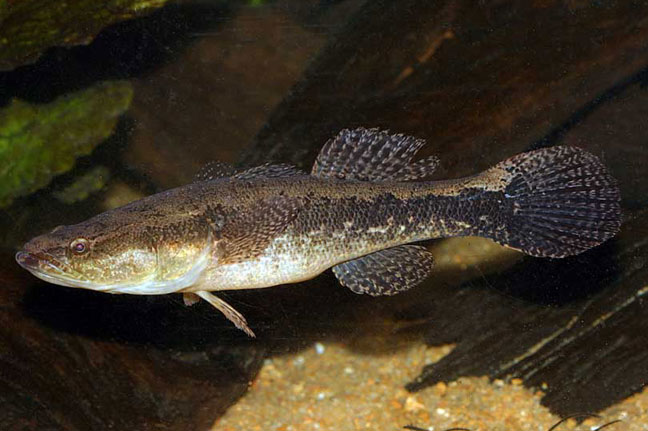Blackbanded Gudgeon, Oxyeleotris selheimi (Macleay 1884)

Blackbanded Gudgeon, Oxyeleotris selheimi. Source: Dave Wilson / Aquagreen. License: All rights reserved
Blackbanded Gudgeon, Oxyeleotris selheimi (Macleay 1884)
More Info
|
Distribution |
Known only in northern Australia from the Adcock River, WA (125°49'E) to Cooktown, QLD (15°S), but probably also in New Guinea; benthic, inhabiting freshwater rivers, creeks and billabongs, usually in slow flowing water amongst aquatic vegetation, woody debris or undercut banks. |
|
Features |
Dorsal fin VI + I, 9; Anal fin I, 8-9; Pectoral fin 17-19; Gill rakers (lower limb) 6-7. Body elongate, cylindrical, anteriorly depressed, posteriorly compressed, depth 4.5-5.5 in SL. Head depressed, profile straight, 2.75-3.2 in SL. Snout slightly shorter than eye to as long as eye, tip before lower margin of eye; Eye diameter 4.5-6.0 in head length; interorbital 1-2 eye diameters. Lower jaw protruding, mouth oblique, reaching to below middle of eye; jaw teeth in several rows, upper jaw with outer row slightly enlarged; outer row in lower jaw at front and a few teeth laterally of inner row enlarged. Head pores minute; some open pores around eyes and along posterior margin of preopercle. Mucous canals radiating under eye; two canals longitudinally on cheek; anterior nostril long in tube, posterior nostril short and not tube-like; nostrils and adjacent pores surrounded by an indistinct patch of papillae. Scales on body ctenoid, cycloid on nape, breast and belly; longitudinal series 55-60; cycloid scales on head scaled above from dorsal fin to in front of eyes, on cheek and opercle; vertical scale rows 62-69; horizontal scale rows 19-20; predorsal scale rows 40-48. Two dorsal fins, the first dorsal fin much lower than body depth; height of second dorsal about 0.67 body depth; caudal fin rounded, slightly pointed; Pectoral fin rounded, as long as head without snout; Pelvic fins separate, slightly shorter than pectorals. |
|
Size |
Maximum size around 55 cm SL, commonly to 30 cm. |
|
Colour |
Dark brown dorsally, lighter ventrally with narrow dark stripes on sides; median fins and pelvic fins with small dark spots forming transverse bands. |
|
Feeding |
A nocturnally active carnivore feeding on fishes, crustaceans and aquatic insects. |
|
Biology |
Oviparous, benthic spawners; females deposit eggs onto a hard surface and males guard and fan eggs until hatching. Eggs are fusiform, 2-2.5 mm long and 1 mm wide. Larvae hatch after 3-7 days, depending on temperature, and begin feeding within days of hatching. |
|
Remarks |
Nocturnally active. Initially described by Macleay as Eleotris planiceps Macleay, W.J. (1882). The fishes of the Palmer River. Proc. Linn. Soc. N.S.W. (1)7(1): 69–71 [69] but subsequently renamed as the name is a junior homonym of Eleotris planiceps Castelnau, 1878. |
|
Similar Species |
Frequently confused with O. lineolata. |
|
Species Citation |
Eleotris selheimi Macleay, W.J. (1884). Supplement to the descriptive catalogue of the fishes of Australia. Proc. Linn. Soc. N.S.W. (1)9(1): 2–64 [33] [nom. nov. for Eleotris planiceps Macleay, 1882]. Palmer River, north QLD. |
|
Author |
Martin F. Gomon |
Blackbanded Gudgeon, Oxyeleotris selheimi (Macleay 1884)
References
Allen, G.R. (1982). Inland Fishes of Western Australia. Perth : Western Australian Museum 86 pp. 6 figs 20 pls [60] (as O. lineolatus).
Allen, G.R. (1989). Freshwater Fishes of Australia. Neptune, New Jersey : T.F.H. Publications 240 pp. pls 1–63 [198] (as O. sp. A).
Allen, G.R., Midgley, S.H. & Allen, M. (2002). Field Guide to the Freshwater Fishes of Australia. Perth : Western Australian Museum 394 pp.
Grant, E.M. (1975). Guide to Fishes. Brisbane : Co-ordinator-General Department 3rd Edn 640 pp. [557] (as O. lineolatus, in part).
Larson, H.K. & Martin, K.C. (1990). Freshwater Fishes of the Northern Territory. Northern Territory Museum of Arts and Sciences Handbook Series Number 1. Darwin : Northern Territory Museum of Arts and Sciences 102 pp. 73 figs [70] (as O. sp.).
Merrick, J.R. & Schmida, G.E. (1984). Australian Freshwater Fishes Biology and Management. Sydney : J.R. Merrick 409 pp. figs 280 col. figs [303] (as O. lineolatus).
Pusey B., Kennard M. & Arthington A. (2004). Freshwater Fishes of North-Eastern Australia. CSIRO Publishing, Collingwood Australia. 684 pp.


